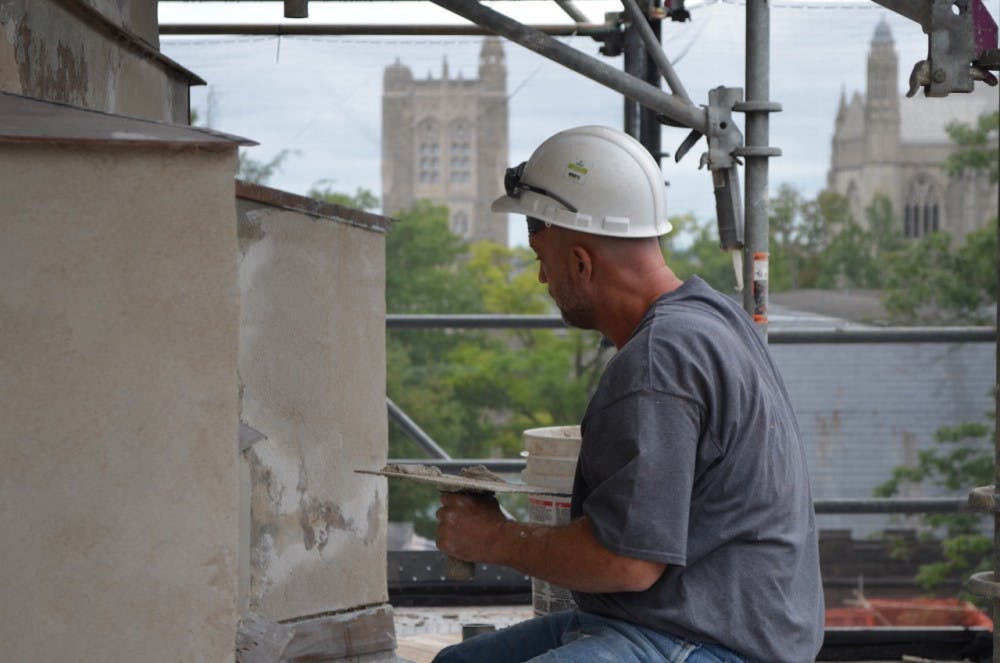Since mid-June 2018, Nassau Hall — the University’s oldest and most iconic building — and the cupola that sits atop it have been undergoing major renovations. The renovations are anticipated to conclude by March 2019, although a recent University press release suggests that the renovations could wrap up earlier.
The changes include replacing the building’s slate roof and roof gutters, restoring the structure of and replacing the four clock faces on the cupola, and repainting the cupola and its weathervane. Additionally, according to Alexis Mutschler, assistant director of special projects in Facilities Operations, the renovations include safety features for workers on the building and a new lighting protection system.
The last major renovation to Nassau Hall occurred in 1960, when the roof was last replaced. The new roof is anticipated to last at least 75 years.
Since its completion in 1756, Nassau Hall has undergone a number of renovations.
In early 1777, during the Battle of Princeton in the American Revolution, Nassau Hall was shelled with cannonballs by American and British troops. After significant renovations, this damage is largely invisible today. There is, however, still a small indentation on the west wing of the hall’s south side where a cannonball struck the building.
The building also survived major fires in 1802 and 1855, both of which necessitated major repairs to the building.
The cupola has been through significant changes as well. Existing in some form since the building’s original construction, the cupola is home not only to Nassau Hall’s bell but to four clocks and a weathervane.
The cupola as it appears now is similar to the cupola on the original Nassau Hall construction. But, after the fire in 1855, architect John Notman, who had designed Prospect House and Ivy Hall (the original home of today’s Ivy Club), was in charge of the rebuilding of Nassau Hall and implemented a new vision for the building. The cupola was central to that vision and was made significantly larger in an attempt to offset two large towers flanking either side of the hall’s front doors. The two towers themselves were designed to accommodate more accessible stairways.
The large cupola and the two towers, constructed in an Italian style, were unpopular at the time and were eventually replaced.
Approximately 10,000 pounds of copper will be used to renovate the cupola this year, according to Mutschler. When the renovated cupola is unveiled, it will no longer be the blue-green color with which most students are familiar. Instead, the new structure will boast the shiny appearance of new copper, but will oxidize to a classic green patina in 15–20 years. Ten gallons of primer paint and 15 gallons of finish coat will be used on the cupola.


The four clocks adorning the cupola — one facing in each cardinal direction — have previously undergone two major modifications. In 1950, the clock faces were adjusted to a more modern style, and in 1980, the clocks’ interiors were digitized. The new clock faces, according to Mutschler, are being constructed by Philadelphia Custom Millwork.
The construction on Nassau Hall and its cupola is being facilitated by a number of different construction firms under the direction of the University’s Facilities team. Massimino Building Corporation of Pennsylvania and Bregenzer Brothers of New Jersey will be doing the work on the building, while Joseph B. Callaghan Inc. is the structural engineering firm employed on the project. The preservation architectural firm for the restoration is Mills + Schnoering Architects of Princeton.
The construction on the cupola, which started over the summer, was still in progress as the Class of 2022 Pre-Rade occurred in early September. Although the Nassau Hall renovations were omnipresent during the freshmen’s ceremonial entry into the University community, many students in the Class of 2022 were unperturbed.
“I’ve never been familiar with Princeton’s traditions; it doesn’t affect me too much,” said Tanvi Kishore, a member of the Class of 2022. “Besides, it isn’t going to take up the whole four years,” she said.
Claudia Humphrey, another freshman, agreed. “I guess they’re doing construction for a good reason, so it doesn’t bother me,” she said.








